The interest in ham radio has absolutely skyrocketed ever since the beginning of 2020. It seems as if people value the ability to communicate with one another and gather information when they’re placed in uncertain situations.
For those who are just delving into the world of ham radio though, it doesn’t take long to realize you’re being swept away with a whirlwind of questions:
- What’s the difference between VHF and UHF?
- Is getting into HF really worth it for my situation?
- How do I communicate as discretely as possible?
These questions and more are the ones that flood the mind of the newbie ham. But perhaps one of the most daunting questions to answer is this: what is the best ham radio for preppers?
Let’s see if we can shed some light on the situation.
Best Ham Radio for Preppers on a Budget
This is going to make me a lot of enemies out there in the ham radio world, but I still believe that the best ham radio for a prepper on a budget is the Baofeng UV-5R.
It’s simply hard to beat ham radio capabilities for all of $30. To my knowledge, nobody else out there even comes close.
Here are the reasons this is the best ham radio for a prepper on a shoestring budget:
Minimal Investment
 This is the chief thing this radio has going for it.
This is the chief thing this radio has going for it.
If you’re a college student, are in between job transitions, or are generally just living paycheck to paycheck but want to get on the air, this is the radio for you.
Let’s face it: the world of ham radio can quickly grow to be prohibitively expensive. Baofeng has put emergency comms abilities into more Americans’ hands than likely any other brand out there.
Related: Frugal Prepping: How to Get Cheap and Reliable Ammo For SHTF
They Are Everywhere
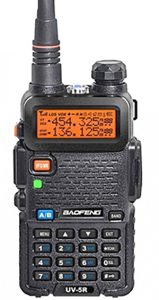
I’m not even sure it’s possible to find a prepper out there without a UV-5R.
Seriously, that’s how popular these things are. And why is that good?
Because it means you’ll have no problem finding somebody who can show you the ropes with your new radio pre-disaster, and should you run into another radio post-disaster, it’s liable to be a UV-5R.
This means that by learning the UV-5R now, you’ll be much better prepared for the eventual contact with one or its user you’ll have post-disaster.
The UV-5R Will Get You On Air This Week
This is tied in to the low price, but I still believe it’s worth mentioning. For many, ham radio is something they’ll “get to eventually”. Part of the reason for this is the price of the great majority of radios they see out there on the market.
Convenience matters, and because saving money for something they’re not even sure if they’ll enjoy is hard, they never end up getting on the air. In the aftermath of a Hurricane Katrina situation, that proves to be an issue.
Just like buying a new Glock and never practicing with it does you little to no good for a WROL situation, so does never buying a ham radio help you in a post-disaster situation. The ability to get quality weather forecasts, local news and more can be very important in a grid-down world – perhaps even life-saving.
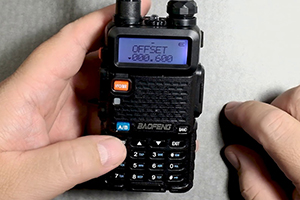 Getting a UV-5R today and then not being afraid to practice and put it through your toughest training will be what will help you to know what to do when it counts. You’ll already have the skillset. With a more expensive radio, you may be afraid to use it and it’ll just sit on the shelf and collect dust.
Getting a UV-5R today and then not being afraid to practice and put it through your toughest training will be what will help you to know what to do when it counts. You’ll already have the skillset. With a more expensive radio, you may be afraid to use it and it’ll just sit on the shelf and collect dust.
You don’t have to worry about this with the UV-5R. It’ll get you on the air this week, and should something happen to it, you’re only out $30.
Cons of the UV-5R
By no stretch of the imagination is the UV-5R a perfect radio. It’s not durable enough to take heavy whacks, its stock rubber duck antenna doesn’t transmit worth a hoot, and the user manual it comes with is virtually worthless.
Related: The Ten Cent Modification You Can Do to Double Your Radio’s Range
Best Digital HT
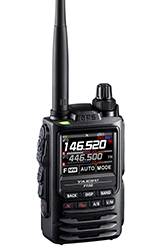 The UV-5R is an analog radio. That’s great for a lot of what you’ll hear out there, but the world is gradually moving towards a digitized amateur radio world. For such, I recommend the Yaesu FT3DR.
The UV-5R is an analog radio. That’s great for a lot of what you’ll hear out there, but the world is gradually moving towards a digitized amateur radio world. For such, I recommend the Yaesu FT3DR.
I discovered this radio via Ham Radio Crash Course, and I’ve got to say – it’s awesome.
Are you going to spend more on this HT than others? Yep. That’s just the cost of getting into digital. It’s a lot pricier than analog.
Bluetooth Capability
This is one of the first really cool things about this radio. There are devices out on the market which utilized Bluetooth to let your HT send and receive packet radio broadcasts.
Seeing that the FT3DR already has Bluetooth capability built in, makes it so it’s that much easier to get involved in these highly efficient messaging systems.
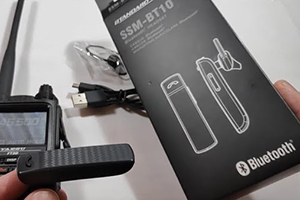 This capability also means that you could use a Bluetooth headset or earpiece while you’re using this radio as well. For EDC options, that’s a huge game changer when it comes to being discrete. If you’re on the move for a bug-out journey or the like, it could make things exponentially easier as well.
This capability also means that you could use a Bluetooth headset or earpiece while you’re using this radio as well. For EDC options, that’s a huge game changer when it comes to being discrete. If you’re on the move for a bug-out journey or the like, it could make things exponentially easier as well.
A Huge Reception Ability
This radio will let you listen in on a huge swath of the radio spectrum. Whether you’re interested in shortwave, the air band, or regular 2m, you can do just about everything (minus HF) with this radio. That’s a lot of radio for your buck here.
Related: Why Do Government Officials Want To Ban Ham Radio? It’s Already Begun In California
Cons of the Yaesu FT3DR
It’s hard to really hammer anything down for cons here. Yeah, the price could most certainly be considered an issue, but when it comes to digital radio, this is a pretty fair number to ask for. The thing is pretty tough too. So really, I don’t see much to complain about here.
Best Base Station Ham Radio for Preppers
Perhaps you’re not as interested in an HT and are looking for a good quality base station to set up in your apartment, condo, or house.
If this sounds like where you’re at – if you’re looking for something with a little more oomph, and that you don’t have to worry about getting moved about all over the place – then I think you need to get an HF base station.
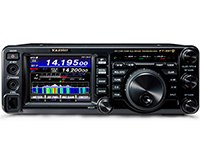
Getting into HF is expensive, but I think if you’re going to do it, why not get the most bang for your buck.
That’s why I think the best base station ham radio for preppers is the Yaesu Original FT-991A.
It Does Everything
You can do everything with this radio:
HF/UHF/VHF/UHF, it’s all there. This means you can pick up just about any signal out there another prepper with a radio is sending out.
You don’t have to worry about buying one radio for VHF/UHF, another for HF, a dedicated scanner, and so on.
The FT-991A is truly a one-stop-shop when it comes to a base station for ham radio.
A Spectrum Analyzer is Attached
I really like the real-time spectrum scope as well. What this does is take out a lot of the guesswork for finding where the chatter is.
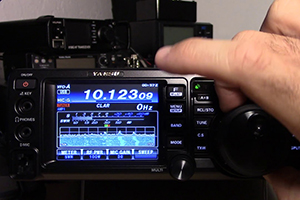
If you’ve ever turned on your radio, hit the ‘scan’ button, and have not been able to find anything, you know how frustrating it can be. You don’t have to worry about that with the FT-991A. It’ll tell you exactly what parts of the radio spectrum are experiencing traffic, meaning you can tune in as quickly as possible.
No guesswork, which is beautiful.
Cons of the Yaesu FT-991A
There are two main cons with this radio: the price and learning how to use it.
For starters, this rig normally runs around $1500. By the time you add an antenna, coax cable, a DC power supply, and so on, you’re going to be well into spending two grand. That can be prohibitively expensive for many.
Secondly, there’s a bit of a learning curve with this radio. It can do a lot, and so you need to learn a lot. Yaesu has some pretty good instruction manuals, but you’re going to need to do quite a bit of online video learning as well.
Related: Quick and Easy Cheat Sheet to Learn How to Operate a Ham Radio
Best Overall Ham Radio for Preppers
I think if we’re going to nail down the qualities of the best ham radio for preppers we would end up with the following list:
- Good shock resistance
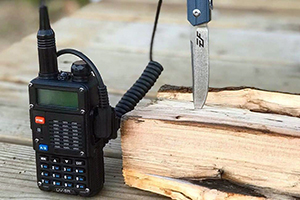 Ability to handle rain without getting fried
Ability to handle rain without getting fried- Easily portable
- Dual/Tri-band capabilities
- User friendly
- Easy to program
- Economically friendly
The radio I think easily hits the mark with all of these traits is The Yaesu VX-6R.
If you are looking for just one radio to purchase – if you want to make your comms investment once and get it over with – I can’t recommend this radio highly enough.
Here’s why:
Great Shock and Rain Resistance
A post-disaster world is uncertain, and so you need a radio that’s going to be as tough as nails. It can get bumped and jostled about as you jump for cover, hike through the rain, and so on. Notice that inherent to these two needs are the understanding that the radio is portable.
While massive base stations have their place, the radio you’re liable to have available to you when disaster strikes is a handheld radio (known as an HT, for handy-talky).
To add a dash of irony, right after I got up from working on this article I (accidentally) dropped my VX-6R off of the kitchen table and then spilled an entire bottle of water on it. I wasn’t happy. But the VX-6R was none the worse for wear, and still functioned great!
Dual/Tri-Band Capabilities
The Yaesu VX-6R is technically a tri-band radio – being able to access 2 meters, 70 cm, and 260 cm – but due to its not being able to access the full range of the 260cm band, Yaesu can’t advertise it as a tri-band. It’s not just that which sets the Yaesu VXA-6R apart, however.
Aside from your being able to talk on two of the most common beginner ham bands out there (2m and 70cm – 260cm isn’t used very often), you also gain access to a host of other pre-programmed frequency ranges.
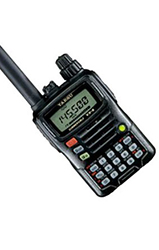 You want to listen to pre-programmed mariner frequencies? Check.
You want to listen to pre-programmed mariner frequencies? Check.- You want to listen to the aviation frequencies? Check.
- NOAA weather forecasts? Check.
- You want to listen to Voice of America, as well as similar broadcasts internationally? Check.
- Regular FM country music broadcasts? Yep, it can get those too.
That’s a massive amount of information that you can have at your fingertips within a moment’s notice in a post-disaster world.
Related: The Disaster Myth Narrative: No One Panics, No One Loots, No One Goes Hungry
As User Friendly as Possible
While I do recommend that you go ahead and purchase the programming software at the same time you buy the radio (it makes things easier), the Yaesu VX-6R is actually not bad to work with from a manual standpoint either.
Pretty much any radio out there is easier to work with via computer programming than it is to use the touchpad though, so I think that’s something of a given.
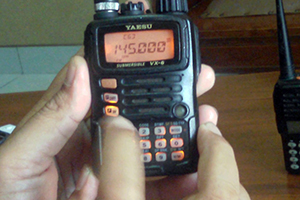
The real test is when it comes to having to quickly input a new frequency when you’re out in the field. For this, you have to know how to do so in the first place, and a good manual is key to this.
If you’ve purchased several radios in the past, you know that not all of them out there have quality instruction manuals.
The Yaesu VX-6R blows a lot of the other ones I’ve seen out there out of the water. It truly is a joy to use, and I think you’ll find so as well.
Economically Friendly
You’re looking at all of $300 or so to get everything you need for this radio to operate. That’s relatively affordable and gives you a lot of radio for your money.
Cons of the VX-6R
To date, I haven’t noticed any. This little radio has been an absolute workhorse, and I’m thoroughly enjoying using it.
If you’re looking for a ham radio, I can’t recommend this one highly enough.
See You On the Air
Wherever you find yourself amongst this list, hopefully it has helped to prove of some service to you. Ham radio is confusing, and the greater majority of writings out there for such were obviously written by engineers and from a highly technical standpoint.
For me, that made getting into ham radio rather scary. I suppose my main issue was that I was nervous I was going to buy an expensive piece of junk that I would never learn how to use.
It took a lot of research a lot of asking around, and a lot of experimentation, but these are the conclusions I’ve come to. I hope they are of some benefit to you, and that you’re able to use them in your own prepping journey.
Are there other radios out there you think should have made this list? Have you had the opportunity to use any of the above? Let us know in the comments below!
You may also like:
 Sour Tea Helps You Avoid High Blood Pressure
Sour Tea Helps You Avoid High Blood Pressure
Do You Know Why You Should Never Put A Tall Fence Around Your House (Video)

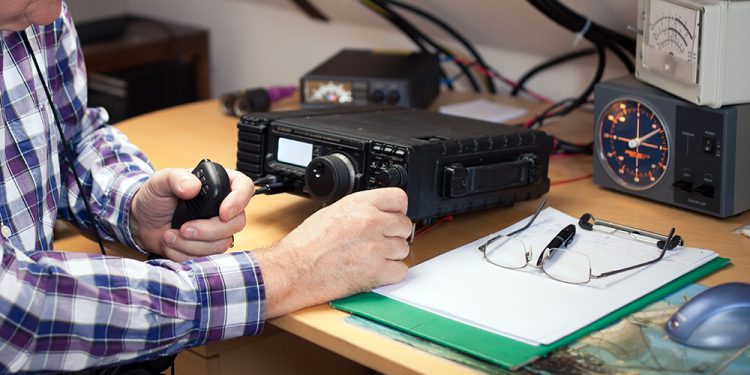













I’m just wondering can these be tracked by some other device.
If there made in china, Remember it is china. NO trust there or here. thanks china milley. you trader scum bag.
How do we know if they did not plant a device that can be tracked or lesten to and then the enemy “HERE” milley, can listen and then track you
We are to get rid of all trackable things,
License ?
phone ?
any one with a chip ?
animal with a chip ?
credit or debit card ?
portable radios, CB’s ?
any thing blue tooth ?
what else??
I’m just saying. the enemy “Here” and abroad can track you by some form.
Can they track you with these devices. Any Real proof out out there.
just looking for more info on trackable devices.
Good article. got some good info.
As for tracking, in aviation a “temporarily disoriented pilot”…aka lost…) will key his radio transmitter and a few flight service stations will triangulate to find his position. The longer keying the “mike” the better the location is determined. With any radio signal there is a path or trail. Short transmit and relocate allows for not being pinned. That is the best if you are transmitting.
Great subject here today. Will look into the radios.
Thank you. Robert.
That’s some of what I am looking for. Good info.
Just stay moving or use the radio as a bring in and get.
Thanks
I don’t think they can track you for just listening. Only when you are transmitting. Am I correct here?
@ spike
That’s some more info I am looking for. Just what you asked.
Post it, if you find out any info on this.
Thanks.
Really gets me to thinking. How can we know what’s going on out there or talking to some one, with out being tracked by what we are using to transmitting. ???
Red ant
My first job after the Army was with VA Beach Animal Control. Before to long I was chipping animals. They don’t have a power source, they are not gps tracking. The can’t even be read without the “wand” and even then it has to be almost right over the chip to read. We had one that we were about to euthanize, scanned multiple times per policy, gave him the 1st injection to calm him down, as we were turning around from the final scan, still had thumb on the trigger when we FINALLY got a beep . The chip had migrated to his snout. We were scanning the nape of the neck, were we are supposed to scan. Even then we only get like a 16 digit code that we have to call in to get the owners info.
So if your pet is chipped, I highly recommend doing it and keeping your contact info up to date, you don’t have to worry about that giving away your location.
Are you sure of that today.
I saw that they have a chip, now that has a battery and works off of the area that is best for the function of the chip. One being on the right hand and I think around the head area.
The man that created it did not no the bible and then some one told him to read Revelation and when he did he was heart struck that he just created the Mark of the Beast. Now after he found out about it, he excepted Jesus. But the damage is done. So there is a chip out there just waiting to be put in to use.
Do you really trust what they say, yes maybe back then but no trust today.
I would not chip my dog, just because it’s a CHIP…
Maybe they are chipping new born baby’s with out your consent. ?
Remember we are dealing with satan…
Thanks for the info
Man I appreciate the INFO. That is helping me. Got some new crap. It’s a pain to work. but I still have my old C/B and radio combo. Plus more old stuff from back in the 1960 and 1970 and maybe some 1980’s stuff.
I new I would use it some day.
Thanks John.
Well, I did chip my dog, and I did have some reservations. The chips are more like antennas that vibrate when next to a radiation source then a computing device, BUT, I still do not trust them. IMHO, Most of us are already chipped one way or another and there is an (cloning center) AI inside of everyone’s head at night as far as I can tell. The whole 5G thing is a canard, they think they can block our connection to the father.
I am one of the few that can actually hear the ‘frequency” (for lack of a better term) these things and some of the most demonic sounding things are the cheap floor fans from china. I do keep around old school stuff, though I do have the FRS radios.
@ John
Yes sir you are right. G5 is a very bad thing for us true human’s. I see what’s going on here right in front of our faces.
They will never stop me from my Father GOD…
Thanks for the post.
Keep up the Faith…
Off topic.
Hey go and look up this card game. it called illuminati card game. it will BLOW YOUR MIND. came out in 1995.
Just read and look at the cards. it’s in our faces and we can’t even see it.
Good questions. There is an app for android phones that will give a pretty good indication of the local RF field density; I tested it against a calibrated field strength meter (thanks Navy). It tracked with the calibrated meter fairly well. So, what you will want to do after getting the app set up on your phone is to record the ambient RF field where you will be evaluating your radio. Write it down as normal. Next; go around and turn off everything that emits a signal:smart anything; tablets routers and other cell phones;anything you can think of. Don’t just power down, physically remove power. When you test this time, you are going to record it as background. (might be a suprise there!) Next; power the radio up while monitoring the reading. If you get a rise in EM/RF field strength as soon as the battery makes contact you probably should investigate in greater detail. Another fun project with the EM/RF field strength meter is to see where your microwave leaks when cooking.
i would avoid the bofangs and avoid buying garbage. The HYT is a much better opition for a little more money.
Better rugged and a nice easy to use intertface. you can do a lot with them and not be as worried like the bofangs break in the field.
As far as tracking, you will always be tracked on HF. Licensed users help triangulate your position any time you are on the air. It makes the government’s job easier. Get your license use it legally and you don’t have to worry about being tracked.
Not trying to do anything illegally. Just wanted to know if any of these devices can be tracked.
This info is for later down the road. better to know it now before you get sent to a Fema camp. O, they call them Reform Centers now… New meaning for death camp.
I hope that we are not getting to relaxed. Just because something massive has not happened yet, dose not mean you let your GUARD down.
Just some good old info needed…
Red ant , Illegal is just a sick bird
isnt that fun…… people trying to rat you out.
You would think that, by the way it was wrote…
How does one get a license for these things?
if you’re in the US >> study the online study questions available for pre-testing – if you have half a brain you’ll have your license – you won’t know much of anything >>> you’ll be a newbie driver on the interstate driving 90 after an all video driver’s class and “road test” ….
SO when SHTF, who will it be to ck and see if I even have a License. Is that the other half of the brain, you mentioned.
Not this time I’m talking about, it’s after SHTF…
In Australia the first to get is the ‘Foundation’ Licence. It’s not too hard and allows access to HF, 3.5MHz – 29.7MHz. VHF 144MHz – 148MHz, UHF 430MHz – 450MHz.
I have a cheap Baofeng UV-5R and home built antenna for using inside.
Got to ARRL.com. it had all the information you need to get licensed. You can also find the nearest testing facility. I also suggest using Ham Radio Exam. It’s an app by Ray Watson. I used the app for less than a week and tested and received my ham radios technician license.
Roy Watson not Ray Watson.
hamradioprep.com
My uncle was a Ham Radio enthusiast. You could spot his house from miles away due to the humongous antenna in his back yard. His basement was full of equipment. As a kid, I would sit there with him and watch him operate all sorts of dials and buttons in amazement when he talked to people on the other side of the world. All So complicated back in the day. This here seems rather doable even for me!
My cell phone can allow me to do that now. /s\
I have 2 baofeng -5s and a -8.
At 5 watts and a good antenna, they should get out as far as a decent CB rig.
Monitoring/ scanning channels for the time being.
I have found some commercial traffic, unsure how they can use that frequency unlicenced.
A lot still eludes me.
Hi Chip. The CB will talk farther than the baofengs will. Why? The frequencies that the CB uses travel farther than the frequencies the Baofeng use. VHF and UHF are basically line of sight. Their RF signal will bounce off things like trees and building, but VHF and UHF are not long distance traveling frequencies. CB frequencies are part of the HF frequencies that will bounce off the layers of the atmosphere, therefor able to travel much longer distances. Keep in mind the Solar Cycle that we are in too.
This was a good article. I recommend the Yaesu FT70DR, it is more affordable though it does not have the 220mhz.
I made a comment about the Yaesu FT70DR being more affordable. I was talking about being more affordable over the Yaesu VX6R radio. I do have 2 Baofeng uv5r+ radios. They are a good cheap radio.
Rod
kc7vqr Ham call
wrfa299 GMRS call
Out of the box, the UV-5R is pre-programmed with odd frequencies that are useless in the US and will likely get the user in trouble with the FCC. There is good information online on how to program it properly using free software.
After some research and personal recommendations I bought a Tecsun PL 880. Listening only. I would like to know of some frequencies that preppers use regularly. After Talk Radio is banned from the airways, Short wave will be our only means of getting information of what is going on.
420.420 is an easy freq to remember.
I must respectfully disagree. Unless you can hit a repeater, assuming a repeater is operational, you would be better off with a cb rig. But in terms of amateur radio, a simple hf rig and a dipole antenna will far outperform any handheld. In addition, You will have several bands at your disposal, each with it’s own propagation attributes which offer everything from local to world wide communications. By the way, I have several handhelds as well as hf rigs and fifty plus years of experience.
Regards,
Don Galaway
NV5X
For serious long-range communications, the ICOM IC-7300 all-mode HF transceiver is by far the best bang for your buck available in the “brand-new” modern HF radio market. You can literally talk around the world with it using a simple di-pole antenna. Yes, you need a license but after SHTF, who cares..
As far as UHF/VHF FM 2-way radios go: Yes, Chinese HTs are the best value going if you are on a budget. The UV-5R is the most popular and there are a ton of accessories available for it. Don’t pay more than $30.00 for the radio. Get some spare batteries and get a Nagoya NA-771 (or equivelant) antenna for it. The ones that come with the radio are garbage. Also, do not buy the Baofeng external microphone for it. They are garbage. Get a Commountain brand mic off of amazon if you need a Lapelle mic for a Baofeng radio. Last thing I will say is that these radios transmit fine, but the receiver is not of the greatest quality. It is perfectly useable and for the price, you can’t beat it. Japanese radios (Icom, Kenwood, Yaesu, Alinco, Motorola, etc.) are of much better quality, but cost hundreds of dollars more.
Ken Jones K5MXJ
I have two Panasonic, model RJ-22 May 1966, they say that they can connect with a CB. but not for sure. I did get them to work and they both will work together, but have yet to try them out on a CB. Channel A and Channel B.
Also have three hand held CB units, Midland Model 13: 861 that work on double A battery’s and 12 volt and 110 A/C power and a very long antenna still trying to get them to work, they work but not much pick up.
Are these any good. Got all for 2.00 dollars at a garage sale. Are they worth the time???
CB is a great short-medium range (even long range when the conditions are right) communications solution. It is essentially 27Mhz (11 meter) AM HF radio. Any radio is only as good as it’s antenna. If you set one up as a base station, be sure to get a good high quality 12v power supply of 10 amps or more. Spend a little money on a decent antenna, and you won’t be sorry. Do a Google search for “Antron 99”, “Maco V58”, “MFJ Super Penetrator”, “star duster”, or “astro plane.” These are some of the famous/popular CB base station antenna designs that have worked/sold really well over the years. CBs are famous for all of their diverse vehicle installation/mounting/antenna options. I won’t go into that here, but they do work great on vehicles, even at ranges of hundreds of miles, in some cases. As far as hand-held “walkie talkie” CB radios go, they are a compromise at best. The wavelength of 11 meters requires a very long (or extremely compromised) antenna. This is not the best match for handheld radios. However, a good CB handheld with a “rubber duck” springy antenna, can usually suffice for things like vehicle-to vehicle communications on/during a road trip.. Just don’t depend on them as a sole form of communications when the range is likely to be several miles or more. To be honest, a couple of good cheap ($30.00 Baofeng UV-5R) chinese VHF/UHF handheld radios will fill the same role and cost you alot less in batteries these days.
Ken Jones K5MXJ
Thanks again for the info. Good to know.
I think it was easer with a sting and a two cups. LOL
Thanks so much to all…
Having obtained my license back in mid 70s, and being limited to Morris Code for the first two years before upgrading to Technician then skipping over the General to obtained the Advance, I will say the most important aspect of Ham Radio are the mentors and other club members to guide you and be a source of used equipment. Yes the day of using an old TV to make your first transmitter may be history to many, I had fun and learned a lot. Now I help the youth in our church learn about radio. Planning to help 10 boys make their first crystal radio set this month. I guess what I am saying is find a Club, Mentor, and learn from them before slapping a batch of money down, heck they may let you barrow equipment, then go with them to a Ham Fest (radio garage sale) they will let you know what is a good buy that is in line with your level. My first equipment was Hallicrafters – Heathkit then moved up to Galaxy (talked to MARS with that radio). There is a lot of possibilities in Amateur Radio. Go to U-Tube and find Jeri Ellsworth AI6TK, listen to her story of mentors.
Great Advice. Radio is a very broad and multifaceted field/hobby. Why learn everything the hard way when someone more experienced can teach you the easy way? Find an “Elmer” if you can.
Ken Jones K5MXJ
Not to be nit-picky, but it is Morse Code, named after Samuel Morse, one of the inventors of the telegraph. I suspect that our good friend Predictive, has struck again. I was in a Marine Corps Reserve Comm company for two years after I got out of the regulars. It was called CW in the Marine Corps. Unfortunately, I wasn’t a radio operator. I was a Remington Raider. I don’t think being a radio operator then would help me now. Even the Alpha Code was different, i.e., Abel, Baker, Charlie, Dog, Fox etc… Vacuum tubes all around. The hand-helds were better than shouting, but not by much. It wasn’t until one got on the jeep mounted radio that one got any distance. We still had telephone packs that one operated by spinning a handle much as one sees in really old motion pictures.
To all the hams who replied to this article, thank you very much for your input. It is much appreciated by me. One of the things keeping me from moving up from the Motorola hand-helds is not knowing what I needed.
LCC – You’re in better shape then me. Heck, I thought I needed a whole basement full of equipment! My uncle worked at Grumman Bethpage for many years and I see on the link to ARRL.com provided by Mike Bitter it’s an operator testing site. My uncle also was the family “repairman.” Now I suspect I know what he was doing with all those old radios and TVs!
Thanks for your USMC service, Chuck. We still refer to Morse Code as CW, and the Pheonetic Alphabet is largely a matter of preference but does still tend to follow the Military (UN agreed apon) standards.. (Alpha Bravo Charlie Delta Echo Foxtrot etc.). If you are interested in handheld radios, Motorola is really hard to beat in terms of quality/performance, in my opinion. There are definitely more options these days in terms of consumer end-user operation friendliness and budget-friendly pricing… But, Motorola has been a major player in the commercial and institutional comms markets for a LONG time.. Pretty much since the 60s..It’s hard to beat.
I’m looking into a HAM radio(s) and I’m new to the raido world. My question and I may have overlooked the answer here, but what is the range of these raidos? I’m interested in what’s going on out there locally around me, in a SHTF senario YES…but I also want to be able to contact my family that live far away (at least 150-175 miles). Will all HAM radios reach these distances as long as we each have a radio?
The answer is yes.
And no.
The handy talkies , unless tied into a repeater that may or not be there, have limited range.
Terrain and atmospheric condition.
I had a Motorola crystal talkie pick up someone else @ 25 miles once.
More common is a mile or so with a basic handheld unit, with no repeater.
With a base set up, and properly tuned antenna (many days) there is no distance transmitted limit.
Heck, there are still radio waves, man-made and star made that have been traveling for millions, billions of years.
I commented earlier but I’m sure it’s lost in the shuffle. The short answer is hf (high frequency) radio. With it you can communicate around the block or around the world depending on which band you are on, time of day, time of year and even the eleven year sun spot cycle. Forty meters is an all around workhorse for short to intermediate comms. Eighty meters is also good but a long wavelength means a long antenna. Twenty meters is great for longer distances. I worked my best dx (long distance) on ten meters but it is subject to the sun spot cycle, so I wouldn’t recommend it. There are several additional bands but the ones mentioned are the ones I use primarily.
A good used hf rig can be had for two or three hundred bucks. The older tube rigs won’t have all the bells and whistles but they’re reliable. Most of them run on twelve volts dc power so can be used as a permanent or portable operation. And in a shtf situation you want reliable instead of fancy. Add a cheap antenna tuner, some wire and a couple of insulators for a dipole and you’re in business.
I’m brand new to this subject, but I just gotta know this : do these things gotta be registered somewhere; is there a monthly fee; what kind of maintenance is required?
Hi Jeannie. You do not have to register a radio for Ham, GMRS, CB or FRS. You do need to take a test to get your Ham license and that license is only good for the person taking the test. For GMRS, you can go to the Federal Communications Commission website and fill out the form online and pay online and in about 3 to 5 days you will receive an email with your GMRS call sign. For GMRS license they are good for your entire family and some relatives. In 10 years you will need to renew both Ham and GMRS licenses. Hope this helps.
Rod
kc7vqr Ham call
wrfa299 GMRS call
You as a radio operator have the license.
The transmitters are not.
No fees, but u should join the nearest ham club so you can use their repeater.dues is all u need and u should get info and help from the club.most have instruction on how to get ur ticket. U may find a mentor who can show u operating proceedures and tips. Good luck. Uncle Cy-k1tes. Over 63 yrs and counting
You forgot to mention GMRS. It is up and coming, easy to get in to, growing in leaps and bounds. Easier and cheaper to get a license ($70 for 10 years that covers the entire family… still waiting for the lower $35 promised costs from the FCC…). They use repeaters as well. Many good HAM operators also have a GMRS license.
Both HAM and GMRS transmit over larger ranges than CB or FRS. Raddiotty GM-30 (yes, it’s Chinese, but most often used and costs around $35 or less) is a decent intro radio, super simple to set up and use without programming from a computer (already comes programmed except for reporter times), and good introduction to radio operations before committing to HAM.
Both options are good for SHFT situations. But for newbies to radio, FRS or GJRS might be better and quicker to learn options.
Hi Fern. GMRS is UHF frequencies and will not talk farther than CB.
Rod
kc7vqr Ham call
wrfa299 GMRS call
It’s a matter of opinion and location that defines what the best options are. I was just pointing out that there is a new player in the group that people aren’t always aware of. Notarubicon breaks down the options on a very diplomatic and unbiased way. For anyone who might be interested, check him out as well as others who have their own ideas, and then decide for yourself: https://youtu.be/dJPzPgo5HVw
During an EMP event UHF is first to recover. VHF takes longer. HF takes forever. Just saying.
Uncle Cy-k1tes 63 + yrs and counting.
Always cool reading on Preppers! niio
Along with my Baofeng BF-F8HP I have an Alps RFinder no Code Plug Android DMR Radio which will grab any and multiple repeaters near you no matter where you are across the globe for you to operate on, when you loose phone service your cellphone is now a handheld ham radio, it is capable of 2 SIMS and 2 SD cards, I bought it for pacticality, most times when I’m up in the toolies I don’t have cellphone service, nice to have a smartphone with a built in Ham radio, only have to carry one device, the antenna also switches out with Baofengs SMA female antenna, as far as the android side of it, it currently only has 8.1 android operating system, with capabilities of next firmware upgrade. Price is roughly $1k which is stll cheaper than a galaxy.
Good article. I’ve had CB radios, minor league stuff. My best-performing mobile rig was a cobra 29 peaked & tuned with a Wilson 1000 mag mount antenna. I could talk from home to a CB shop about 25 miles away, and I was impressed by that.
I am very interested and always thought the only way to communicate without being spied on is with two cans and a wire between them? Now, this Ham radio concept interests me but is there a vegetarian option too?
Good one 🙂 niio
In Australia the first licence is the ‘Foundation’. It’s not hard to pass. You can access HF, VHF and UHF. I have a Baofeng UV-5R and a simple home biult antenna for inside.
Maybe this is a little off current discussions, But, about 20 years ago it was possible to get Radios which in addition to receiving FM/AM would allow one to tune in the FM sound of the TV Channels. Usually it was only for VHF Channels but some radios would tune the UHF Channels. So if you had a power outage You could still get info off a small hand held radio. But all that ended when the government ended Analog Transmissions and forced everything to Digital Transmission. So, my question is, does anyone know of a somewhat portable radio which will receive the “off air Digital” signals from TV Stations so that one can get emergency info and weather for the larger area where one might live. In my case, I live in a very rural area which lacks local radio/TV stations but I can get the digital signals from 30-40 miles away but when a power outage occurs all I have is battery powered radios. If I could receive the digital signals it would be a wonderful asset.
LCC (Left Coast Chuck) might know. I don’t know where Ohio Prepper disappeared to but he definitely would.
First, the Baofeng radio is made in Communist China, America’s number one enemy. This radio links to your cell phone and whether or not you are transmitting or just listening, you can be tracked. Yes, the price is cheap, but every cent you spend on Chinese junk goes towards their military and hence you are funding our worst enemy, an enemy second only to Satan himself.
Anything made in America?
Base stations are preferable if you want more power and greater performance. However, they are frequently more expensive and difficult to operate, particularly if you are a beginner.